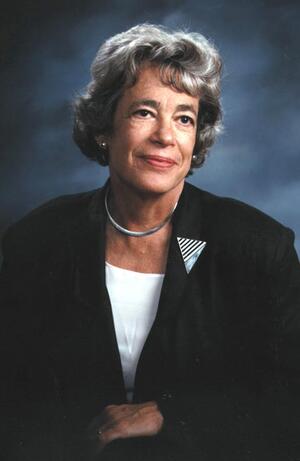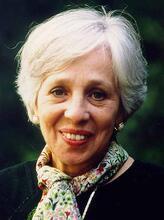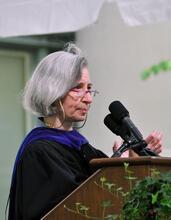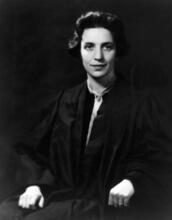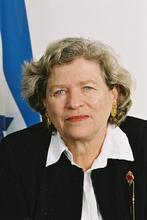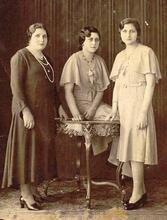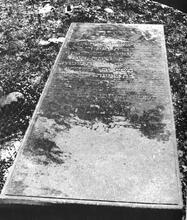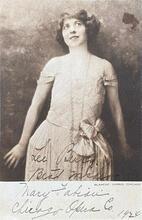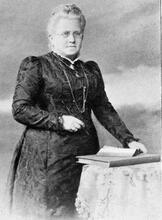Elga Ruth Wasserman
Having experienced the sexism rampant in higher education herself, Elga Ruth Wasserman guided Yale through the difficult process of becoming a co-ed university. Wasserman and her family fled Germany in 1936 and settled in Long Island. She earned a PhD in organic chemistry from Harvard in 1949 and later served as assistant dean of the Yale Graduate School from 1962–1968. She stepped down in 1972 to avoid becoming the sole advocate for women on campus, and went back to school herself, earning a JD from Yale in 1976. After clerking for the Second Circuit Court of Appeals, she ran a family law practice until 1995, and in 2000 published a study on women scientists’ careers, The Door in the Dream: Conversations with Eminent Women in Science.
In 1970, after the first year of coeducation at Yale College, Elga Ruth Wasserman wrote, “Women students need an unusual sense of self to persevere in a predominantly male setting.” A graduate of Smith College (B.A. 1945, summa cum laude and Phi Beta Kappa), Harvard (Ph.D. 1949 in organic chemistry), and Yale (J.D. 1976), Wasserman was an expert on issues facing women and other “minority” populations in academia, and was most famous for overseeing the entrance of the first coeducational class at Yale College in 1969. Wasserman’s own unusual sense of self led her through remarkable careers in science, university administration, activism, family law, and publishing.
Early Life & Family
Wasserman was born June 30, 1924, to a Jewish family in Berlin. Her mother, Louisa Sternberg (1898–1973), traced her ancestry to a prominent Jewish family in fifteenth-century Prague. Her father, Dezsoe Steinherz (1888–1973), was the son of a renowned Hungarian rabbi. Dezsoe had served in the Austro-Hungarian army during World War I but left Hungary after the war, moving to Germany to study chemical engineering and law and to work as a chemical patent attorney. Louisa and Dezsoe had two children, Elga Ruth (b. 1924) and Hans Andor, nicknamed Andy (b. 1927). The family celebrated Hanukkah, Passover and Christmas in their home, as did many assimilated German Jewish families. In 1933, when the Nazi government closed their Montessori school, the children transferred to a Jewish primary school where they learned modern Hebrew, Jewish history, and Zionism.
In 1933 Nazi police harassed Louisa’s brother, a left-leaning journalist. Elga’s family immediately began preparations to leave the country. Over the next three years her mother took Elga and her brother on numerous trips to visit relatives abroad, taking with her money and possessions to leave in relatives’ safe keeping. In addition to transporting much of her family’s wealth out of Germany, Louisa investigated a suitable future home. In 1934 or 1935 she traveled to Palestine. Much to the disappointment of the adventuresome young Wasserman, Louisa concluded that Palestine was too rural and that her husband would have difficulty finding work there, and she applied instead for visas to the United States. An English-speaking au pair lived with Wasserman’s family during their last two years in Berlin. Though at the time Wasserman resented this “nursemaid,” she and her brother left Germany in 1936 speaking English fluently.
Louisa’s brother also fled Germany in the mid–1930s, traveling to Czechoslovakia. He soon returned, however, to reunite with his non-Jewish wife and his children, who had stayed behind. Both Louisa’s brother and his wife subsequently died in German concentration camps; their four children left Germany on the last kindertransport to England in 1939. Louisa’s father also died in Germany in 1939. Although Wasserman had been aware of laws that forbade Jews to attend the 1936 Olympics and banned Jews from public facilities, her parents and their German Jewish friends sheltered their children from news of the Nazi atrocities.
The Steinherz family settled in Great Neck, Long Island, in 1937, after a brief stay in Manhattan. Deszoe Steinherz continued to work for the same German company that had employed him in Berlin, but when that relationship collapsed he slowly built a modest patent law practice, assisted by referrals from other Jews. To supplement the family income, Louisa became a successful real estate broker. Elga and Andy received a rudimentary Jewish education at Sunday School in Great Neck.
Education
Propelled by her insatiable intellectual curiosity and her parents’ encouragement, Wasserman excelled at school, skipping a grade to graduate from high school at the top of her class in 1941, not yet seventeen years old. She attended Smith College on a scholarship, exploring her wide interests in chemistry, the history of art, French, mathematics, and sociology. Empathizing with the status of the outsider, Wasserman organized civil rights protests at Smith during the early 1940s, at one point organizing a campus-wide forum on race relations with the activist Roy Wilkins.
Wary of the financial debt that attending medical school would require, Wasserman decided to forgo her career of choice and instead accepted a graduate fellowship to Harvard in 1945 to study organic chemistry, becoming one of only two female graduate students in the department at the time. One year later she met Harry Wasserman, a fellow chemist who had just returned from serving in the army. As soon as she told her thesis advisor of her engagement to Harry, the advisor lost interest in her future career plans, reflecting the prevailing preconception that married women did not pursue careers in science. Harvard awarded Wasserman the Ph.D. in chemistry in 1949.
Marriage & Early Career
Elga and Harry Wasserman married in 1947 and in 1948 moved to New Haven, Connecticut, where he had a faculty appointment at Yale. She worked as a research assistant until a few months before the birth of her first child. From 1950 to 1962, while their three children, Daniel (b. 1949), Diana (b. 1951), and Steven (b. 1955), were young, she held part-time teaching appointments at Southern Connecticut State University and Quinnipiac College and worked part-time for industry. That flexibility, she later reflected, characterized the unfocused career paths of many women of her generation in academia and illustrated for her the conflict between academia’s research and tenure demands and the lack of social support services for young women. Though she might have been able to find a full-time research position in the post-war scientist shortage, Wasserman assumed that having a family and pursuing a full-time career were incompatible goals. Finding a ladder faculty position as a Jewish mother of three seemed out of the question. There were at that time no women professors on science faculties, certainly no married ones with children.
Overseeing Coeducation at Yale
Contacts through the Smith College career counseling office eventually helped her get a full-time appointment in 1962 as the Assistant Dean of the Yale Graduate School responsible for the physical and biological sciences. The Dean of the Graduate School, John Perry Miller, welcomed Wasserman as one of his “ladies”—the female deans from whom he expected unconditional loyalty and service. Appalled when Wasserman informed him in 1968 that she was ready for greater challenges and professional advancement, Miller refused to assist her job search.
Undeterred, she accepted an appointment that year from Yale University president Kingman Brewster to serve as the “Special Assistant to the President on the Education of Women and Chairman of the Committee on Coeducation.” Brewster told her that he knew the title was awkward, but that he could not give her the title of “Dean” because the deans of Yale College, all men, had made it clear to him that their stature would be diminished if a woman joined their ranks. Wasserman devoted the next four years to preparing for and overseeing the first coeducational classes of Yale College. Brewster appointed her to oversee a transition endorsed by most of the students and faculty, despite the protestations of older alumni. Recruitment beginning in the late 1950s of an increasing number of students from public high schools had supplemented Yale’s traditional prep school applicant pool and created a diverse student body of men comfortable with coeducation. Once Princeton announced in the fall of 1968 that it would become coeducational, Yale’s course toward coeducation seemed clear.
It was Elga Wasserman’s job, however, to guide Yale College on that course. Navigating the emotionally charged issues of admissions criteria, housing (Brewster had publicly promised to maintain Yale College’s tradition of graduating “one thousand male leaders” each year, but the university had not built additional dormitories to accommodate incoming female students), campus security, and the uneven gender ratio, Wasserman encouraged the Yale community to rethink its image and its values. In September 1969 Yale opened its Gothic gates to 588 women—230 freshmen, 154 sophomores and 204 juniors—in an undergraduate college of over 4000 men.
Wasserman and others quickly recognized the social and educational inequalities that the gender disparity created. Women of Yale College objected to weekend “mixers” that brought busloads of students from women’s colleges to Yale, while men at Yale protested their overcrowded living quarters. The absence of high-ranking women in Yale’s faculty and administration became immediately more noticeable and more problematic for Wasserman and others sensitive to women’s precarious position in academia. Gradually the university began admitting more women to the college and integrating them into the campus’s residential colleges and academic programs, but more substantial changes remained elusive. In 1972 Wasserman left Yale University, concerned that her visibility as the specialist in all issues pertaining to women at the university precluded other men and women from taking responsibility for transforming the institution’s gender biases.
Law School & Career
Wasserman entered Yale Law School at the age of 49, graduating in 1976. For the next year she clerked for the United States Court of Appeals, Second Circuit, a post she remembers as her most intellectually challenging. For the next twenty years she developed a private family law practice. She retired from the law in 1995 to devote more attention to her newest project, a study of women who had been appointed to the National Academy of Sciences (86 of whom were living at the time of her study), which culminated in the publication of her book The Door in the Dream: Conversations with Eminent Women in Science (2000). She asked women members of the Academy to tell her about the relationship between their gender and their careers, their ideas for creating gender parity in academia and their secrets of success. Following the publication of the book, she lectured extensively at universities and in industry about the challenges facing women in academia and beyond.
Harry officially retired in 1991 and continued to work daily in his research laboratory, passing away in 2013. Elga Ruth Wasserman passed away on November 11, 2014, at the age of 90. The couple had seven grandchildren.
Selected Works by Elga Ruth Wasserman
Bunting, Mary I., Patricia A. Graham, and Elga R. Wasserman. “Academic Freedom and Incentive for Women.” Educational Record 51/4 (1970): 386–391.
Wasserman, E. R. and Switzer, E. The Random House Guide to Graduate Study in the Arts and Sciences. New York: Random House, 1967.
Wasserman, Elga R. “Coeducation Comes to Yale College.” Educational Record 51/2 (1970): 143–147.
Wasserman, Elga Ruth, Arie Y. Lewin, and Linda H. Bleiweis. Women in Academia: Evolving Policies toward Equal Opportunities, Praeger Special Studies in U.S. Economic, Social, and Political Issues. New York: Praeger Publishers, 1975.
Wasserman, Elga R., et al. “The Changing Status of Women Attorneys in Connecticut.” Connecticut Bar Journal v. 56 (August 1982): 344–348.
Wasserman, Elga. The Door in the Dream: Conversations with Eminent Women in Science. Washington, D.C.: Joseph Henry Press, 2000.
Numerous scientific articles.
See also: “In Memoriam: Elga R. Wasserman, helped bring co-education to Yale,” Yale News, November 14, 2014.
Gay, Ruth. The Jews of Germany: A Historical Portrait. New Haven: Yale University Press, 1992.
Oren, Dan A. Joining the Club: A History of Jews and Yale. 2nd ed. New Haven: Yale University Press, 2001.

